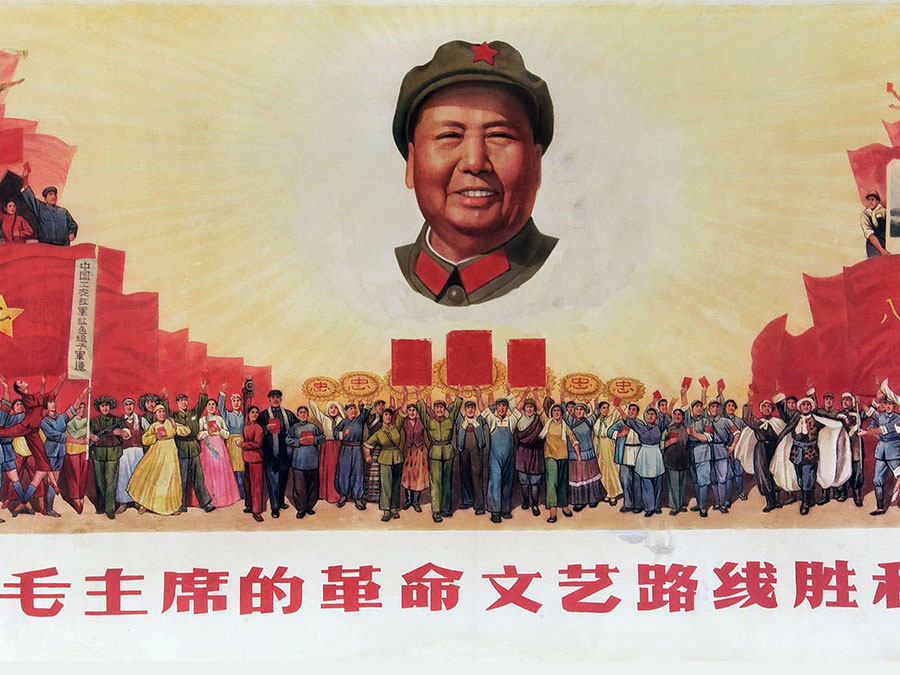Timeline
1921 Mao Zedong established the Changsha branch of the Chinese Communist Party.
1924 First United Front created with the GMD to fight the warlords.
1927 Jiang Jieshi ended the alliance.
1934 The Long March
1935 Zunyi Conference
1937 Invasion of China by Japan.
1945 The civil war restarts in China.
1949 Mao and the CCP win the civil war, the Peoples’ Republic of China (PRC) begins.
1950 Korean War, Chinese involvement, Marriage Law, Campaign against the counter-revolutionaries and land reform.
1953 First Five-Year Plan, the Korean War ends.
1954 First PRC constitution
1956 Hundred Flowers Campaign, Khrushchev’s destalinisation speech.
1957 Anti-Rightest Movement CONSOLIDATION ENDS?
1958 The Great Leap Forward begins.
1959 Lushan Conference, USSR stops assistance to China for their nuclear programme.
1961 Sino-Soviet split
1962 The Great Leap forward ends. The Socialist Education Movement begins
1964 China’s first nuclear bomb developed.
1966 Cultural Revolution begins
1967 China builds its first hydrogen bomb.
1971 Lin Bao dies controversially, after being nominated as Mao’s successor in 1969.
1972 US President Nixon visits Mao in Beijing
1976 Chairman Mao and Zhou Enlai died. The Cultural Revolution ends.
Rise to Power
Political Ideology
- The Chinese Communist Party entered a new strategic situation after the defeat of the Chinese Soviet Republic. Mao reduced the emphasis on the class struggle and economic redistribution and focused on unity and patriotism against Japan.
- Mao learned from this period that effective communication was needed between small groups (for example, CCP committees) and the mass population. No longer can the ‘Twenty-Eight Bolsheviks’ rule alone.
- The Zunyi Conference of 1935 demonstrated Mao’s belief in guerrilla warfare and how the ‘Twenty-Eight’ were out of step with the peasants.
- In the 1920s, he saw the importance of land reform and continued to promote this in the 1930s.
- According to Brantly Womack, Mao claimed that his political theories continued were consistent throughout his career. However, Womack argues that Mao deliberately made general statements about his earlier experiences so they could be interpreted to suit his present policies. He also kept statements about the relationship between Marxism and Chinese culture vague.
- Marx’s class struggle was a major contributor to Mao’s idea of revolution. It provided him with the answer to China’s, especially the peasants’, problems.
- Mao was not an opportunist but attempted to achieve attainable goals. Mobilising and gaining the support of the masses was one of these. However, the failure of the May Fourth movement led him to focus on revolutionary organisation too. It also persuaded him that the revolution would not just happen naturally, it had to be forced. Hence, his infamous quote, “political power grows out of the barrel of a gun”.
- Guerrilla warfare and the establishment of a rural base were practical solutions for Mao, not a theoretical innovation, the priority was survival in the 1930s and both of these helped to achieve this. The peasants, not the proletariat, were the driving force for Mao so a rural revolution was planned.
- After 1949, the focus changed. There was no need for survival so Mao now turned to cement his ideology. The people needed theoretical guidance. He continued to allow cadres to have independence and hold them accountable, but nationally he introduced a number of policies to promote his Communist vision and both encourage and force people to support it. See the timeline above.
- Michael Lynch explains that ‘As a Chinese revolutionary, he rejected Western values but made it his mission to match Western achievements.’ But in trying to rid the country of foreign influences, ‘he adopted a Western political theory – Marxism.'(Mao, p. 2)
- He chose this ideology because he saw its destructiveness, and he believed China had to be destroyed before being rebuilt.
- Mao read classical Chinese and Confucian history more so than Marx or Lenin. One could argue that he ruled more like a traditional emperor rather than a communist leader. For example, he sought the reverence of the people whereas Lenin criticised those who idolised him.
The Long March
From one of Mao’s speeches… (from ThinkIB )
” We say that the Long March is the first of its kind ever recorded in history, that is, it is a manifesto, an agitation corps, and a seeding machine…For twelve months we were under daily reconnaissance and bombing from the air by scores of planes; we were encircled, pursued, obstructed and intercepted on the ground by a big force of several hundred thousand men, we encountered untold difficulties and great obstacles on the way, but by keeping our two feet going, we swept across a distance of more than 20,000li (about 6.750 miles) through the length and breadth of eleven provinces. Well, has there ever been in history a long march like ours? No, never.
‘The Long March is also a manifesto, It proclaims to the world that the Red Army is an army of heroes, and that the imperialists and their jackals, Jiang Jieshi and his like, are perfect nonentities.
The Long March is also an agitation corps. It declares to approximately two hundred million people of eleven provinces that only the road of the Red Army leads to their liberation. Without the Long March, how could the broad masses have known so quickly that there are such great ideas in the world as are upheld by the Red Army?
The Long March is also a seeding-machine, it has sown many seeds in eleven provinces which will sprout, grow leaves, blossom into flowers, bear fruit and yield a crop in the future.
To sum up, the long March ended with our victory, and the enemy’s defeat .”
- The CCP and Comintern decision to adopt conventional war methods to fight the GMD in 1934 led to defeat. The previous four GMD offensives had failed against the guerrilla tactics of the Communists. This defeat led to the declining influence of Otto Braun and the Comintern, and the rise of Mao. He disagreed with the change in strategy and his foresight allowed him to distance himself from the defeat.
Perspectives
- The CCP would argue the ‘Great Man’ theory, Mao had the foresight to understand the military reality, the other leaders did not.
- The GMD could argue that without the growing influence of the Japanese in China, the CCP would have eventually been destroyed. The Long March was not a success and should have been the dying embers of the communists.
Cult of Personality
Notes are taken from ‘How to be a dictator – The Cult of Personality in the Twentieth Century’ by Frank Dikötter.
1924 to 1949
- Mao had been partly financed by the Soviet Comintern since he was twenty-one years of age. As such, Moscow had huge influence on how the Communist Party in China would grow. For example, in 1924 and in Mao’s home province of Hunan, Russian advisers funded peasant associations to start a revolution. They turned the society upside down, becoming the masters and taking excessive revenge on the formerly wealthy and powerful. Mao saw the violence and death and was enthralled, believing that if the associations were to become hundreds of millions, they could create a new China.
- But this belief in peasants went against the Marxist ideology whereby the proletariat rose up. Therefore, Mao had to adapt this thinking to suit China, a nation of peasants. On 7 November 1931, he proclaimed a Soviet Republic in Jiangxi. It was financed by Moscow and introduced its own currency, stamps, etc. However, the Central Committee stripped him of his command because they were critical of his guerrilla warfare methods. Zhou Enlai became the leader but was defeated by the Kuomintang in 1934. This led to the Long March, Mao leading the remaining forces to Yan’an and safety (it was a mountainous region and difficult for their enemies to reach). This march was to prove important for decades, Mao using it as proof of his theory that he was destined to take power and lead China forward.
- In 1935, the Soviet Union poured huge praise on Mao labelling him as ‘vozhd’ or great leader; only Lenin and Stalin were called this at the time. Mao decided to build on this announcement to cement his position as leader of the Communist Party. He needed to deter rivals and create a belief in his skills to lead China. Mao employed a young US reporter Edgar Snow and talked about his mythical youth and career as a revolutionary. The consequent book ‘Red Star over China’ was published in 1937 and became an immediate success. He was ‘an accomplished scholar of classical Chinese, an omnivorous reader, a deep student of philosophy and history, a good speaker, a man with an unusual memory and extraordinary powers of concentration, an able writer…and political strategist of considerable genius.’ Mao had also come from the very bottom of Chinese society and it was his destiny to regenerate his country.
- ‘On New Democracy’ was also written in 1940 during the war against Japan. It was a pamphlet aimed at all revolutionary classes, explaining the democratic virtues of the Communist Party. It was all fiction but brought more support and attracted thousands of students, teachers, artists, writers and journalists to Yan’an. However, Mao was suspicious of this intelligentsia, preferring loyalty rather than free-thinking. Consequently, in 1942 he launched the Rectification Campaign – this intimidated the whole party to ensure absolute loyalty (and rid the party of Soviet influence too). More than 15 000 ‘enemy agents and spies’ were identified, being tortured, imprisoned or even executed. Importantly for Mao, he gave the task of implementing the Rectification Campaign to Kang Shek. Once over, he was blamed for the excessive violence, leaving Mao as the benevolent leader.
- Mao also set up a Central General Study Committee, full of loyal allies such as Liu Shaoqi. They controlled everything in Yan’an and ensured everybody was loyal to Mao. This included rivals swearing loyalty, even being humiliated to prove this. Zhou Enlai was one example, after which he became Mao’s loyal servant for decades to come. Importantly, unlike Stalin, rivals were rarely shot – they would work tirelessly to prove their ‘renewed’ loyalty.
- From this period onwards, the Cult of Personality intensified. Mao was revered as a virtual deity and all had to acknowledge his genius and benevolence to the Chinese people. Portraits, badges and songs would spread these messages across Yan’an and China. In April 1945, Liu Shaoqi called Mao ‘the greatest theoretician and scientist in all of Chinese history‘.
Resources
Student Perspectives
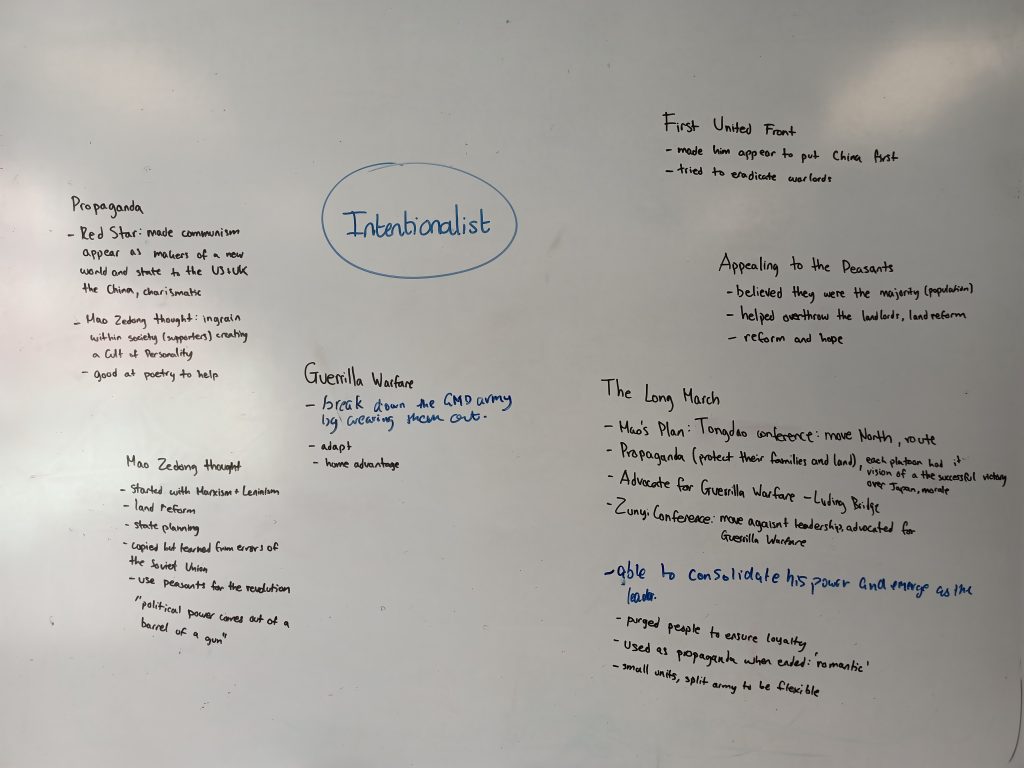
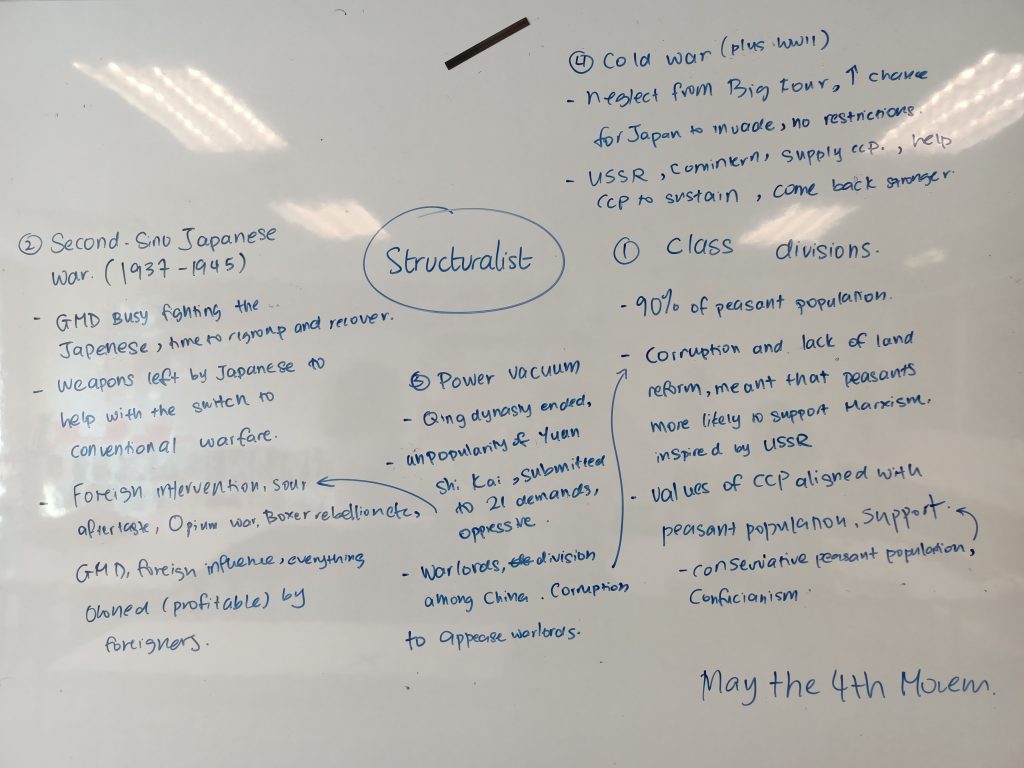
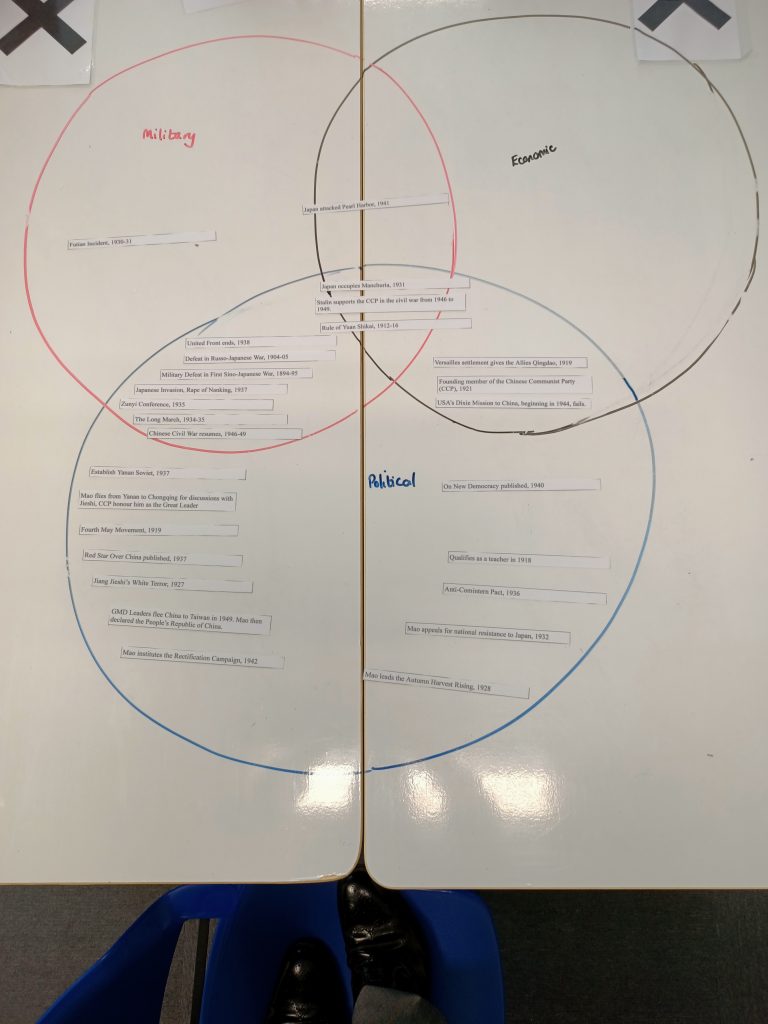
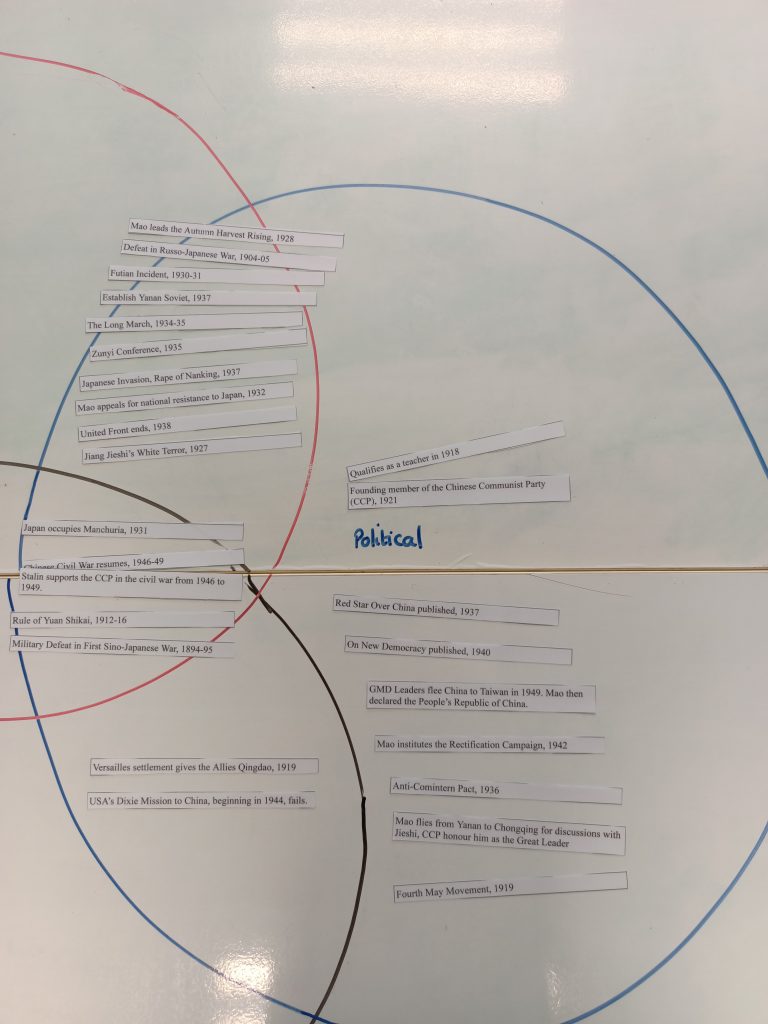
Consolidation of Power
Cult of Personality
1949 to 1976
- After the Chinese Civil War ended, all adults had to study ‘Mao Zedong Thought‘, many having to go back to school to do this. At the same time, the promises made in ‘On New Democracy’ were broken gradually. The Party wanted to eliminate all private property, collectivise agriculture and massively increase defence spending. To maintain the support of the peasantry, Mao encouraged them to denounce their landlords and take what was ‘rightfully’ theirs. Two million died in the implementation of this policy. Moreover, people were also classified; they were either good, wavering or hostile to the revolution. This classification influenced your access to food, education, health care and employment. And if you were judged as hostile, this label was passed onto your children too!
- Just as in Nazi Germany and Stalin’s Soviet Union, books were burned and only those artists and authors loyal to Mao could work.
- He also hired a photographer called Hou Bo and her pictures (Mao Zedong swimming across the Yangzi in 1955) were published in their millions.
- Mao styled himself as a philosopher-king, one who thinks for all. His words, especially poetry, were published everywhere and educational courses set up to study (praise) his work.
- He made sure he was rarely seen, creating the illusion of being a god. He knew he was a great orator so he did not speak very much at public gatherings.
- Mao’s cult of personality suffered a setback when Khrushchev denounced Stalin after his death, so much of what Mao had said and done previously was copied from the former Soviet dictator. The speech was also a challenge to Mao’s leadership, Zhou Enlai, Liu Shaoqi and others spoke of collective leadership rather than just him. In response, Mao launched the Hundred Flowers Campaign, where people could publically voice their concerns. It backfired but the rise in opposition to the government meant that those who advocated a collective were now united with him.
- A further strategy to reinforce the cult of personality was the Great Leap Forward (see above). The disastrous policy could have ended him as the ruler of China. He was saved in that Lin Biao called it a great accomplishment and Zhou Enlai demonstrated his loyalty by taking the blame for many of the policy’s failures.
- Mao’s ‘Quotations of Chairman Mao’, also known as the ‘Little Red Book‘ was carried by all soldiers of the People’s Liberation Army. This ensured he had support from within the military.
- He tried to reassert his power and cult of personality again with the Cultural Revolution (see below). He targetted those who ‘discussed’ the Great Leap Forward, people who spoke out during the Hundred Flowers Campaign and encouraged students and the young (who all had years of CCP education behind them) to eliminate any evidence of the old culture, even if this included people. The young Chinese showed huge devotion to their leader and destroyed temples, churches, shops, books, in honour of him. During this time, people tried to outdo each other in showing their loyalty to Mao. Badges, posters, pictures, and books were made in their millions. The demand outweighed the supply and this led to other industries suffering – aluminium became in such short supply that Mao had to put a stop to the badge craze.
- In 1968, Lin Biao launched the Three Loyalties and Four Boundless Loves. It took Mao’s devotion to new heights, all offices, school, and factories had an altar with Mao’s picture in each. The Chinese people would see him every day, bowing as they did so. Busts and statues were also made, 600 000 in Shanghai alone.
- However, Richard Walker explains that to help create this image of Mao, stories of the Long March focused only on his exploits and heroism, omitting the names of those purged or who were rivals.
- The PLA was used to implement the Cultural Revolution. However, it also made Lin Biao, its leader, very powerful. So after he died in a mysterious plane crash, the power of the army was curtailed, even purged.
Mao as Superman, by Richard L. Walker
- “…It is possible to count the stars in the highest heavens, but it is impossible to count your contributions to mankind.” Peking Radio, 6 December 1967
- By 1972, it was almost impossible to find any area where Mao was criticised.
- The cult of the great leader, great teacher and great supreme commander obscured the real Mao. Even American historians referred to him as Chairman Mao, whereas their own president called just be called Nixon. Only after his death did some in the West begin to question his rule, similar to Stalin in the 1950s.
- In 1958, the People’s Daily wrote “Chairman Mao is a great prophet. Through scientific Marxism-Leninism, he can see the future. Each prophecy of Chairman Mao has become a reality. It was so in the past; it is so today.” (Walker, p. 164)
- Even failures were blamed on others. The best example was Great Leap Forward with Liu Shaoqui and others being blamed for the policy failure. Lin Biao was also held responsible for the excesses of the Cultural Revolution.
- Walker argues that Mao created an environment where people focused on the ongoing revolution rather than any of his mistakes. Tourists were ‘guided’ around the country so would only see the positives of the revolution…just as in North Korea today.
- He also made sure there was no discussion of a successor, ‘Under Mao there have been no regularized methods for appointment, succession, or government organization beyond the will of the leader.’ (Walker, p. 165)
- Mao could have been a ‘superman’ had he retired earlier than he did. Much like Hitler if he had done so in the late 1930s.
Luck
These are events that were not under the control of Mao and the Communist Party.
- In 1936, Chiang Kai-shek was kidnapped and forced to fight the Japanese rather than the communists.
- Japan invaded in 1937 and the GMD bore the brunt of the fighting which ensued. The CCP was in relative safety in rural areas in the meantime.
- The USSR was in a position to help the Chinese communists after Japan left the country in 1945. This aid allowed the Red Army to evolve from one which fought using guerrilla tactics to one which could fight conventional battles.
Force, Land Reform and the Antis Campaigns
- Mao remained loyal to his peasant supporters by rewarding them with land reforms. Tribunals were held for landlords and, if found guilty of the exploitation of peasants, were punished and their land is taken off them. Hundreds of thousands were executed, allowing Mao to rid the country of opposition and ensuring the continued loyalty of the peasantry. The latter is evidence that he continued his strategy of gaining the support of the masses (see Political Ideology above).
- Three-Antis Campaign launched in 1951. The purpose was to eradicate three specific ‘ evils’: corruption, waste and bureaucracy.
- It targetted CCP members who had too close connections to capitalists.
- In 1951, Liu Qingshan and Zhang Zishan, two leading CCP members were arrested for corruption and living a wealthy lifestyle – they were executed the following year.
- Five-Antis campaign launched in 1952. It targetted capitalists who took part in bribery, tax evasion, theft of state property, cheating on government contracts and stealing economic information ( the five evils ).
- The policy encouraged people to spy and report these abuses.
- By 1953 around 450,000 private businesses had been charged with one of the ‘five evils’; around 340,000 were found guilty. Land, property and income were confiscated.
- The Five-Antis campaign generated money for the government and created an environment of fear.
1954 Constitution
- The electoral law from March 1, 1953, provided for one member for every 100,000 people in towns of more than half a million inhabitants, and one for 800,000 people in the countryside.
- The Chairman of the People’s Republic of China was elected for four years by the Congress. He presided over the National Defense Council, commanded the army, appointed and dismissed the Premier, and represented China in foreign affairs.
- All citizens were equal before the law, had the right to vote and stand for election, irrespective of their nationality, race, sex, occupation, social origin, religious belief, education, property status, or length of residence, except insane persons and persons deprived by law of the right to vote and stand for election. The last point is important, as it shows that personal rights for individuals could be abrogated.
- The Constitution stressed the freedom of speech, of the press, of assembly, association, procession, demonstration, religious belief, scientific research, and literary and artistic creation. Citizens had the right to work and that for education.
- Working people had the right to rest and leisure, and to material assistance in old age, and in case of illness or disability. The Constitution also guaranteed the right to make written or oral complaints to organs of state at any level against any person working in an organ of state for the transgression of law or neglect of duty.
Taken from http://www.chinaknowledge.de/History/PRC/prc-event-constitution1954.html
Economy and the Five Year Plans
Just as Lenin implemented the New Economic Policy in the Soviet Union, Mao introduced National Capitalism to solve the economic problems of the country. China had been devastated from both the civil war and the Second World War. Before a successful socialist revolution could take place, there had to be a growing economy. In National Capitalism, Mao worked with business people who were not supporters of the GMD as he needed their expertise. The following is taken from OSC’s Authoritarian States textbook.
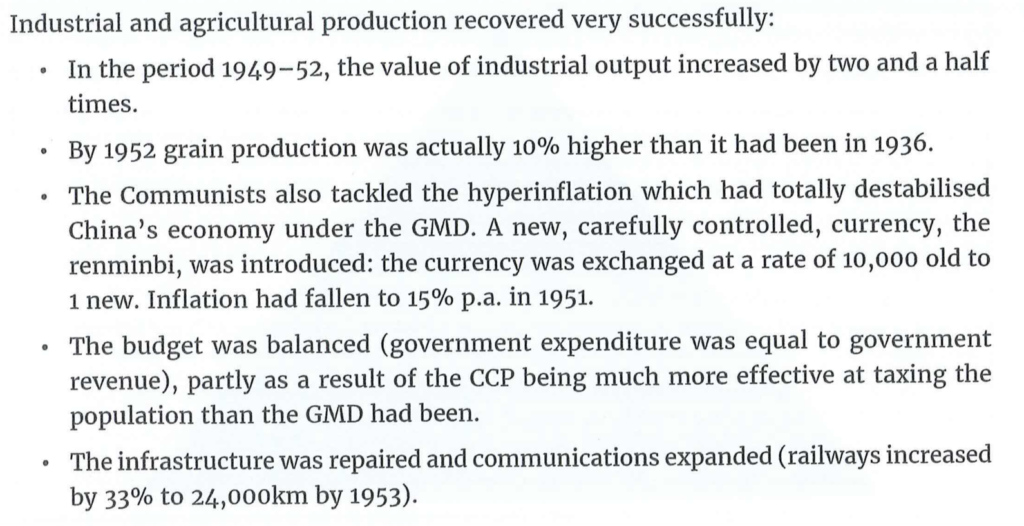
In 1953, Mao tried to emulate Stalin’s Five-Plans to take China even further forward. The following is taken from AlphaHistory
- Michael Lynch argues that Mao’s economic strategy was also designed to seek out the opposition.
- The Five Year Plan was supported by Soviet Russia, which contributed advice, logistics and material support. Moscow provided a small loan of $300 million and, more importantly, the services of several thousand Soviet engineers, scientists, technicians and planners.
- Huge gains in steel, coal and petrochemicals.
- Created an urban/rural imbalance. While 84 per cent of the population lived in rural areas, 88 per cent of government investment was pumped into the heavy industry in towns and cities. Agriculture suffered, leading to Mao’s future policy of the Great Leap Forward.
- Prior to this, Mao introduced collectivisation. Agricultural Producers’ Cooperatives were formed to pool resources (including land) and produce more farm goods. Life expectancy rose from 36 to 57 years, city housing standards improved and urban incomes increased by 40 per cent.
- “The First Five Year Plan produced results that were impressive enough to sustain the Chinese leaders’ dreams .’ Michael Blecher
- Mao saw the first Five Year Plan as successful so he implemented the second aimed at creating more rapid progress – the Great Leap Forward.
Hundred Flowers Campaign and the Anti-Rightist Movement
- In 1956, Mao encouraged intellectuals to offer ideas or criticisms to improve China. He assured them that they would not be punished.
- The policy was driven by Zhou Enlai.
- It was either developed to genuinely improve China or to find potential opponents, who would then be arrested.
- Criticisms were slow to develop for fear of reprisals but by 1957 there were many, probably too many for Mao to accept. Consequently, the Anti-Rightist Movement was launched.
Anti-Rightist Movement
- Between 300 000 to 500 000 ‘Rightists’ (capitalists are considered ‘right’) were identified and either removed from their position of influence or sent to ‘re-education camps’.
- Mao – ‘We must lure the snakes away from their hideouts so that we can kill them.’
Mao and the Soviet Union
- Mao respected Stalin and emulated some of his policies in China. This respect was tarnished after his visit to Moscow in 1949; he was kept waiting for weeks before he was granted an audience. However, when Stalin requested that China become involved in the Korean civil war he agreed. One could argue that he had to because the USSR was the only country which gave China aid. But if he had refused the request and relations became poor, this could affect his position as leader. Mao had spoken of his admiration for Stalin, the USSR and their ideology. Breaking or criticising them could affect the support he had from Chinese communists.
- 1956 and General Secretary Khrushchev changed this situation.
Great Leap Forward
According to Dikotter, ‘we’ know of 20th-century horrors because Nazi Germany fell (the Holocaust), Stalin died (Purges, Gulags, Holodomor ) and Japan (Rape of Nanjing) lost the Second World War. It is more difficult to find evidence to prove the horror of the Great Leap Forward because the communist party is still in power. He argues that forty-five million died between 1958 to 1962.
- The purpose of the ‘Great Leap Forward’, arguably none of these words seemingly fit the event, was to create a huge army of workers for China. Mao wanted the country to overtake Britain in steel production within fifteen years. But as the workers required to produce this had to come from agriculture, the plan was to make food production more efficient. Consequently, villages were to be collectivised, amalgamated to form a larger and more efficient system of production – the communes. This included the land which had been previously given to the peasants in the 1930s and 1940s, was now taken away. Mao was sixty-four years of age by 1958 and wanted to create a lasting legacy before he died. As China had not advanced as much as he had wanted, the Great Leap Forward was the solution to surge past the USSR and other leading nations. No matter than collectivisation failed in the USSR, Mao believed he was cleverer than Stalin and could make it a success.
- The political representatives of the CCP within the communes had quotas and targets to be met. However, the workers and peasants were fearful of the consequences if these were not met and exaggerated the results. Consequently, the CCP took more of the produce than what was possible and the commune faced food shortages and probably starvation.
- Two to three million people were killed because of the violent methods to force people to work or hand over the food. It was not just the famine that killed so many Chinese people.
- People who could work were fed, those who were too sick, old or suffering through severe lacks of food were not. This is a key point in that famine leads to a lack of food and people starve. However, in China during these four years, food was withheld deliberately. In Mao’s words ‘Revolution is not a dinner party.’
- One of the strategies used by peasants was apathy – they did not do any work if the government representative was not present. This would conserve energy and make them less reliant on what food was available. There were stories of villages sleeping through the winter, a human hibernation.
- Another strategy was because of the basic instinct of survival. People fought each other, peasants attacked cadres, stole from trains and granaries, and even sold all possessions including their own children.
- Huge amounts of housing were also destroyed during this time. They were used for fuel, build other things under collectivisation (better villages?) and to prevent peasants hiding resources such as food.
- The Great Leap Forward was a project which also aimed to improve the infrastructure of the country. Canals and railways were to be built. Unfortunately, these efforts were insufficient to make collectivisation a success. Forcibly moving resources such as food and machinery to other parts of the country to establish communes relied on infrastructure, the fact that it was poor meant that much-needed food rotted for lack of roads and rail.
- The communist cadres, although in charge of the collectivisation project, were also punished if they were too honest in reporting what was happening in the country. Those senior officials in the party who criticised the policy were purged during the Cultural Revolution.
- The foreign powers ignored the situation in China, even though the information coming out of Taiwan alerted the west.
- Remembering the biggest mass murder in the history of humanity
- Lushan Conference
- Michael Lynch agrees with Dikotter’s analysis, the Lushan conference of 1959 should have been the end for Mao because of the disaster befalling China. However, only Defence Minister Peng Dehuai had the courage to criticise his leadership. A veteran of the Korean War and a member of the Long March, Peng was a tough man who traded insults with the PRC chairman. However, none of the other leaders, Zhou Enlai, Deng Xiaoping and Liu Shaoqi, had no such courage.
- ‘But in one of the great betrayals of modern Chinese history, the self-proclaimed leaders of the people rallied to Mao and turned against Peng.’ (Lynch, p. 173)
- As such ‘…it was now impossible to deal with a famine that officially did not exist. To keep up appearances, grain continued to be exported abroad even from the provinces where the death toll was mounting daily.’ (Lynch, p. 173)
- The period after Lushan ‘was a study in fraudulence, sycophancy, and terror.’ (Lynch, p. 173)
- Peng was labelled a rightist and removed from power. He suffered terribly under the Cultural Revolution and died in prison in 1974.
- Lynch explains that newspapers contained photographs of a plentiful harvest and the success of the Great Leap forward. And, as with all authoritarian leaders, a scapegoat was found for any problems. Mao blamed peasants for hoarding grain supplies and sent them to laogai, the Chinese labour camps, where ten million were incarcerated. One could argue that he learned from Stalin in how to solve this problem, he himself had blamed the kulaks for the failure of collectivisation in the Soviet Union. They were sent to gulags, the Soviet equivalent of laogai.
Cultural Revolution
Purpose
- Michael Lynch argued that Mao’s intention during this period was to destroy China’s past. He used Lin Biao as a virtual minister of propaganda to elevate him above ordinary politics.
- Mao saw that Liu Shaoqi and Deng Xiaoping had improved Chinese agriculture by allowing peasants to sell their surplus produce. But the return to individual farming meant that his earlier programme, the Great Leap Forward, had failed. Furthermore, the communes were dismantled too. This made them rivals to Mao. The Cultural Revolution would allow him to remove or dispose of them.
- After the failure of the Great Leap Forward, Mao had lost some of his power and influence. Although the CCP was led by the politburo and so power was shared, before the famine he was its leader. To restore this situation, he needed a purge.
How did the Cultural Revolution maintain Mao’s power?
- A key tool for this was Mao’s ‘little red book‘. 740 million of these were distributed between 1964 and 1968, each containing shorts extracts from his writings and speeches. It became a prescribed text for schools and universities and was broadcast to workers to motivate them.
- According to Mao, “The Chinese Red Army is an armed force for carrying out the political tasks of the revolution.” (Lynch, p. 178). Consequently, he made sure each soldier had the ‘little red book’ as their basic training manual. The loyalty of the army was further strengthened and reinforced his power, despite the failure of the Great Leap Forward and his age.
- With regards to Liu Shaoqui, Mao acted vengefully towards him. He was diagnosed with tuberculosis in 1964 so Mao closed down the clinics which would treat him. Then
- The trigger for the Cultural Revolution was the reaction to the play The Dismissal of Hai Rai from Office. Although it was set in the eleventh century, the removal by the emperor of Hai Rai, a government official, was seen by Mao as an allegory of his decision to remove Defence Minister Peng Dehuai. As the writer, Wu Han, had been critical of the Great Leap Forward, Mao forced him to denounce his own play. His friends and supporters were also targeted for undermining Marxist-Leninist-Maoist thought. Unable to cope with the constant persecution, Wu Han killed himself in 1969.
- Mao also overturned the rule, brought by Lui Shaoqi and Deng Xiaoping, that his cult of personality be removed and the country should be governed by a collective. Both men were removed from office too.
- In 1966, Mao announced the creation of a Central Cultural Revolution Group (CCRG) which would identify and remove bourgeois enemies.
- Within this group, the Gang of Four emerged. Zhang Chunqiao, Yao Wenyuan, Wang Hongwen and Mao’s third wife, Jiang Qing, made up the group. It was based in Shanghai and Mao used this and the CCRG to undermine his rivals in Beijing.
- Jiang used the group to pursue her vendettas against those who may have slighted her in the past (Zhou Enlai, Peng Zhen). She also led the campaign to rewrite China’s cultural history (see below). ‘Her work dominated China during the remaining ten year’s of her husband’s life.’ (Lynch, p. 190)
- She censored all art forms, everything had to go through her before it was sanctioned. All foreign powers works were banned and Chinese history was selectively removed.
- An example of the type of production which Jiang Qing supported is shown below.
Q – How did the actions of Jiang Qing affect the position of Mao in China?
Q – If Mao was rarely seen during the Cultural Revolution, did it mean he had lost power?
- And Wang Hongwen‘s name became associated with terror in Shanghai, responsible for the persecution and death of thousands.
- In 1966, Mao instructed several high-ranking party officials to be arrested and tortured, he claimed there was a plot against him. Zhou Enlai and Liu Shaoqi protested but this only added to Mao’s distrust of them.
- As a result of the ‘plot’, the CCRG became more active. Mao may not give them any specific criteria but he did not limit their powers either.
- Mao’s attacks would involve the youth attacking the old. They had been used before in the 1950s (antis campaigns) and were to be the main instrument of the Cultural Revolution. However, he did not respect them, ‘we must liberate the little devils. We need more monkeys to disrupt the palace.’ (Lynch, p. 184)
- Teachers were targeted by students and were encouraged to do so by Mao. These students would form the Red Guards. The attacks on the teachers went against the Confucianist view of respect for elders. It was part of Mao’s plot to continue the revolution (borrowing Trotsky’s view of a permanent revolution) and remove the ‘Four Olds‘ – Old Culture, Old Customs, Old Habits, and Old Ideas (CHIC).
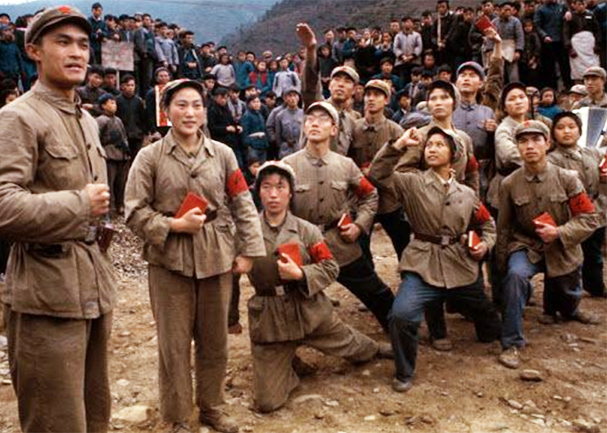
- This went against the Chinese Confucianist culture, respect was elders was ignored. No matter how venerable, all people became possible targets. Even the most ancient and respected artefacts were destroyed too.
- Deng Xiaoping, Liu Shaoqi and Zhou Enlai all tried to limit this destruction and terror but this only led to their demotion in the party hierarchy.
- In July 1966, Mao took his famous swim in the Yangxi River. All the media took an interest and conveyed it to the people. It was symbolic that in China’s greatest river, Mao represented a life force. Mao may have been seventy-three but the swim energised his supporters.
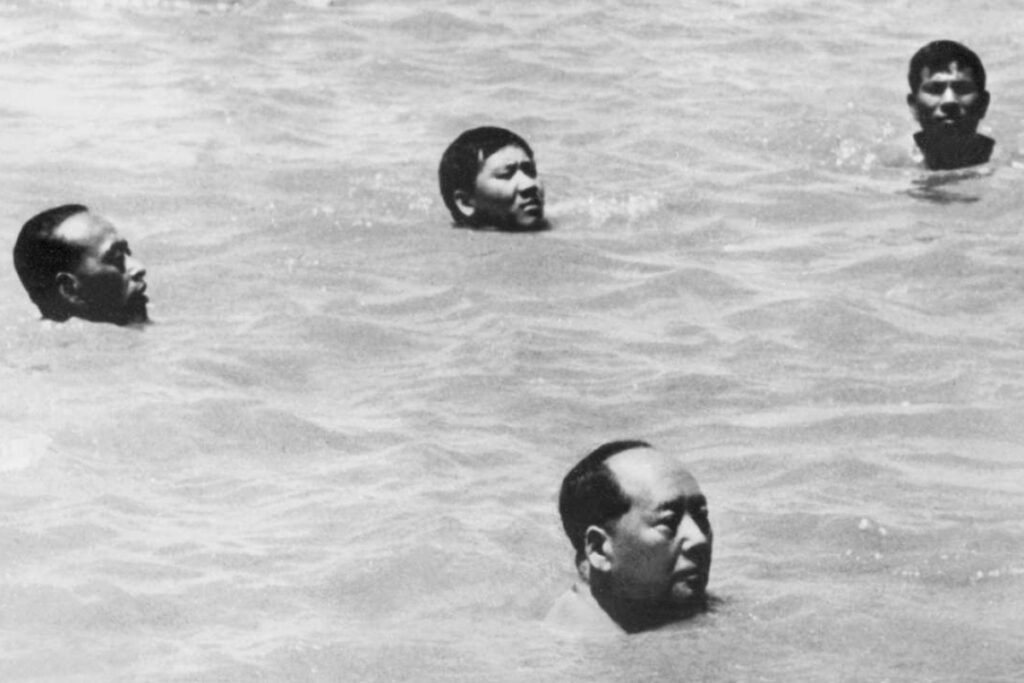
- CCP members also targeted by Mao, even after Liu Shaoqui did so earlier in the decade. A Red Guard demonstration criticised both Deng and Liu. The latter was tortured and forced to ‘admit’ his crimes. Consequently, he was imprisoned and died emaciated in 1969. For Deng, his son was thrown out of an upstairs window, which left him permanently paralysed, and he was eventually exiled to Jiangxi for corrective labour.
- Mao was concerned about coups and plots so removed himself from Beijing for long periods. When returning, he moved from place to place to avoid any recriminations for his actions. He even gave up his personal preference for young peasant women in case he was poisoned.
- However, Lynch argues that even though Mao was absent he was still in control. ‘Everything was done in his name‘. (Lynch, p. 188)
- Dikotter argues that during the Cultural Revolution there were the Red Years of 1966-68, when the Red Guards look for their teachers and the intelligentsia and the Black Years of 1968-1971, when the army takes over. It looks for potential rivals and the educated. Millions are ‘re-educated’ by sending them to the countryside. After Lin Bao dies (in a questionable plane crash) the Grey Years set in, the army no longer in charge.
- Mao changed his view of the Cultural Revolution when China’s workers stopped working. Teachers were one thing, workers, and China’s economy was different. So he brought in the Peoples Liberation Army (PLA) to take over the role of the Red Guards. The latter was ordered to go to rural areas to farm, ‘to go up to the mountains and down to the villages‘. (Lynch, p. 188)
- This allowed Mao to get rid of the ill-disciplined youth with thirteen million of them going into the countryside. After Mao’s death, those who spoke about their experiences felt that they were used. Consequently, they worked even harder for material gain after 1976.
- Two million PLA soldiers supported Mao, showing that he still had the loyalty of the army.
- Mongolia: 800 000, largely Mongols arrested and questioned. Many were tortured and even killed.
- People began to leave the collectives in the 1970s. This gathered sufficient momentum and was too big to turn around by the 1980s. Economically the people changed but politically they did not, resulting in the failed demonstrations in Tiananmen Square of 1989.
Summary of Frank Dikotter
Memories of the Cultural Revolution
Jiang Qing and ‘her’ Cultural Revolution
Perspectives
- Marxist historians could argue that the nationalists, supported by the middle and upper classes, were not able to take power because China was a peasant country, and they supported Mao.
- Intentionalists may argue that Mao saw the struggle of the Chinese peasantry and put forward plans to help their cause. Introducing land reform and preaching a more equal society would bring him the support he needed to become the leader of China.-
- Functionalists may argue that Mao came to power because the country was under-developed and the majority of the population, peasants, wanted change.
Student Arguments
Aims and Results of Policies
Economy
- The Five-Year Plans were somewhat copied from Stalin and the USSR.
- Economically reliant on the USSR in the 1950s, $300 million in loans under the Sino-Soviet Friendship Treaty of 1950 (but these loans only 3% of China’s GDP).
- Soviet expertise also important in driving the economy, 11 000 people working in China during the 1950s.
- Heavy industry improved during the Five-Year Plans.
Education
Land Reform
Power
Culture
Religion
Women
- Mao attempted to get the support from women by passing policies which would create equality in the country.
- He introduced International Women’s Day in December 1949.
- 1950 Marriage Reform Act, women had to agree to be wed.
- They could also divorce and be allowed to keep their female babies., and concubinage was also outlawed. However, is some regions society remained patriarchal (Confucianism stated ‘Women must obey men’) and the laws were ignored.
- Footbinding was abolished.
- Women were allowed to own land (although this was taken away during the first-Five Year Plan).
- Prostitution was outlawed.
- However, women rarely rose in prominence in their communities, earning less than men and generally forced to continue their domestic duties. The propaganda gave a false image (Mao’s quote of ‘Women ‘can’ hold up half the sky’) and even the party cadres failed to carry out the party policies concerning equality.
- Yet the propaganda was effective in that even after Mao’s death women believed he had created better conditions for them in China.
- On balance, women developed the impression that they could have access to better opportunities. Even if only some women took ‘better’ jobs, this was enough to create it.
- A key figure in the CCP during the 1960s was Jiang Qing, Mao’s third wife. She is a good example to use when discussing women in this unit. Jiang Qing.
- Ding Ling was an author, writing celebrated books such as The Sun Shines over the Sanggan River in 1948. She was a member of the CCP but was expelled for her criticisms of the party in 1957 (Anti-Rightist Campaign). She was also imprisoned during the Cultural Revolution, before being released in 1975.
Minorities
Perspectives
Marxist historians could argue
Intentionalists may argue
Functionalists may argue
Historiography
- In the run-up to the Beijing Olympics in 2008, the Chinese government opened some of the state archives to historians. As a result of these, first-hand accounts of the Great Leap Forward and Cultural Revolution were read and revised or even new theories put forward.
- If you are from the West, judging China is not easy because of the differences in culture. People in the West must avoid judging Chinese society and history from their own culture.
- China has had many languages within its history. Translating these into Mandarin or foreign languages can lose some of the meaning and therefore accuracy.
- China has undergone some liberalisation and relaxation since the death of Deng Xiaoping in 1997. (AlphaHistory) More balanced accounts of the Cultural Revolution were made available.
- When China was ‘friends’ with the USSR and Stalin, the Chinese Revolution was supported by communist countries. This changed after Khrushchev’s attack on Stalin in 1956 with relations between the two countries deteriorating.
- However, Marxist historians tend to be critical of Mao as he altered their ideology to suit his own needs. Arguably, he was only a token Marxist, some scholars arguing that Marxism was European and did not transfer easily to Chinese culture.
- But Maoist histories continue the ‘Great Man’ theory of him. Japan was defeated because of him and his party. The Hundred Flowers Campaign was a trap for his enemies rather than a strategic error. Mobo Gao – Historian
- Western historians, especially during the Cold War, would criticise Mao and argue that Jieshi was the true leader of China. Chinese involvement in the Korean War only added to this view. This only began to change after President Nixon visited Mao in 1972.
- Ross Terrill explains in Mao in History that the US viewed Mao as a junior Stalin until the 1960s when the Sino-Soviet split occurred. Even after 1972, Nixon and Kissinger tended to defend Mao and his attempts at social engineering rather than the excesses and errors of the Great Leap Forward. It was not until the Deng Xiaoping era that Mao was heavily criticised in the West. Evidence of this is that in the 1960s anti-communist scholar Richard Walker put the death toll of the Great Leap Forward at one to two million. Only in 1996 did Jasper Becker put the loss of life at thirty million, a more accepted figure today.
- Terrill explains that as the West is developing more relationships with China, there are more studies done. Previously, to be blunt, China did not matter very much.
- He also argues, with evidence to support his point, that Mao was under the influence of drugs when making decisions. These were usually sleeping pills but led to his erratic behaviour and sometimes slurred speech. For example, Mao refused to allow the US table-tennis team into China in 1971. But during one night when he was heavily drugged he changed his mind.
- However, in the 1930s and 1940s, when fighting Japan, books such as Edgar Snow’s Red Star Over China encouraged people in the west to view Mao positively.
- However, in the late-1960s and 1970s student revolutionaries and would shout his name and in South America and Southeast Asia, guerrilla movements would study his work.
- Revisionist historians have been critical too, arguing that his megalomania and vanity led to huge amounts of violence and suffering within the country. Jung Chang – Historian , published Mao: The Unknown Story in 2005. It portrays him as evil although it caused controversy as it is seen to be too one-sided.
- Frank Dikkoter – Historian
- Michael Lynch
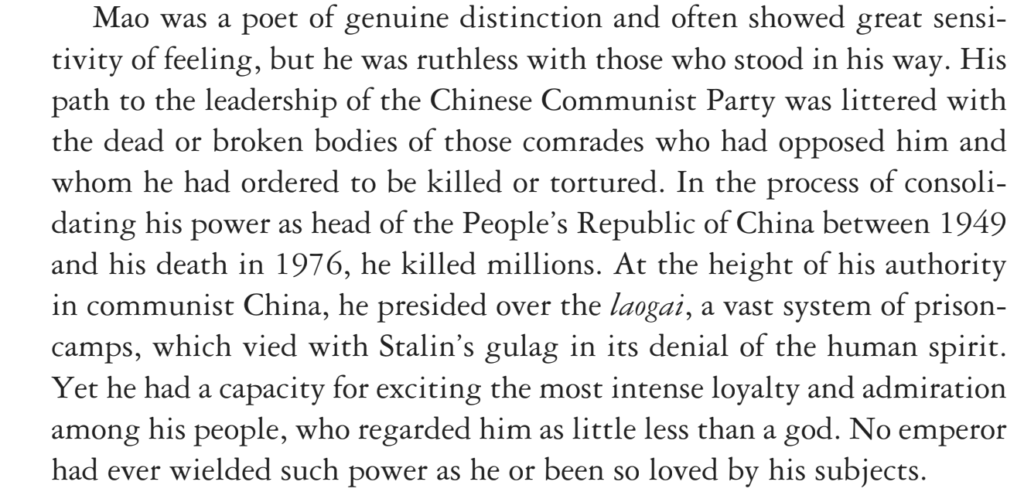
The issue of Mao’s rule and legacy remains today. Watch the debate below.
https://alphahistory.com/chineserevolution/chinese-revolution-historiography/ https://www.slideshare.net/gabr0088/ib-history-historiography-mao
Thesis Statements
A. Without Mao’s cult of personality, built up over decades, the Great Leap Forward would have been the end of his power.
B. Chairman Mao maintained his power through violence, both the fear and the practice of it.
C. Mao transformed Chinese society from a divided nation in 1949 to one largely loyal and dependent upon him. https://www.nytimes.com/2017/10/23/opinion/how-mao-molded-communism-to-create-a-new-china.html
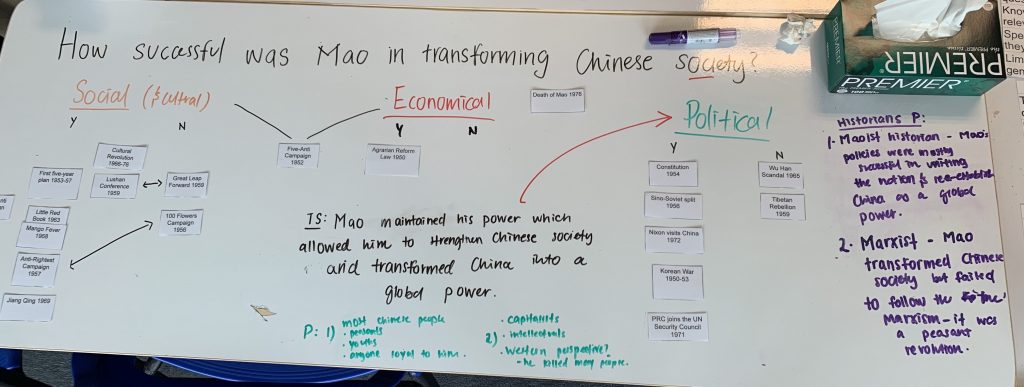
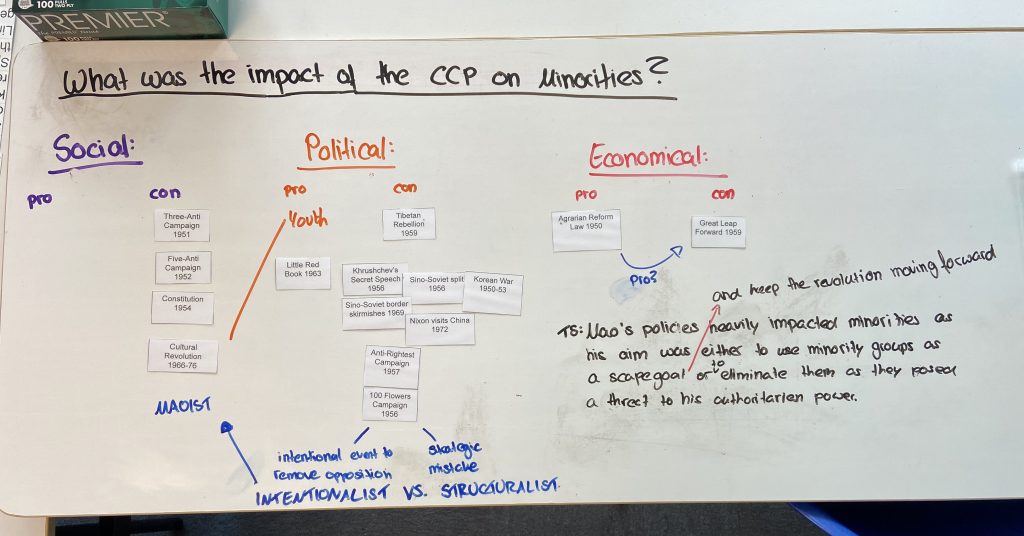
Bibliography
Walker, Richard. “Mao as Superman” Journal of International Affairs, Vol.26, No. 2, 1972, pp. 160-166.
Womack, Brantly, “The Foundations of Mao Zedong’s Political Thought”, University of Hawaii Press, 1982, pp. 180-202

